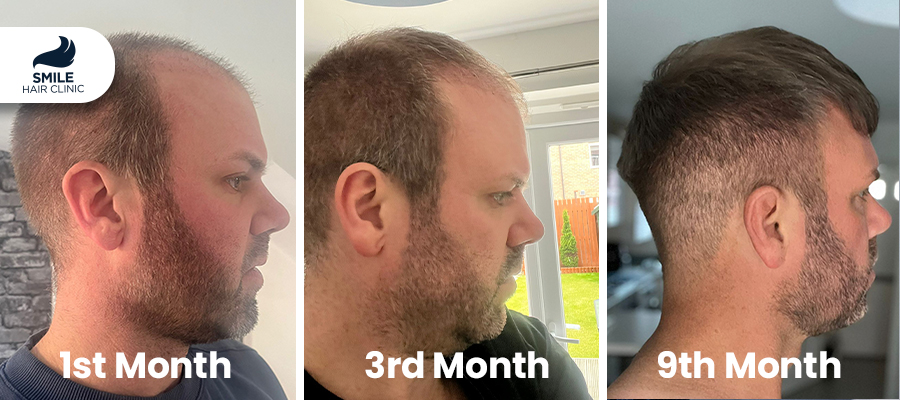When Will I See Results After a Hair Transplant?

When Will I See Results After a Hair Transplant? A Month-by-Month Breakdown
A hair transplant is a big commitment to returning a fuller head of hair. Although the procedure doesn’t take more than a day, the results develop slowly over months. We will also discuss what to expect during your recovery time, such as the time frame for significant post-transplant milestones. So, here, we explain the hair transplant results month by month.
Month 1: Recovering and Shedding
What to Expect In The First Month After Your Hair Transplant? You might feel the following immediately after the procedure:
Scabbing and Redness: The area with transplanted hair is typically red, and small scabs form around each graft. These tend to fall off within 7-10 days.
Tenderness: Some soreness or tenderness may be expected in the donor and recipient sites. Pain is generally mild and can be managed with pain relievers.
However, in weeks 2–4 post-surgery, you may notice some shedding of the transplanted hair. This is known as “shock loss,” a standard part of the process that is not cause for alarm. The hair follicles are intact and will start generating new hair shortly.
Month 2: The Waiting Game
In the second month, nearly everything externally visible about the procedure (redness, scabbing, etc.) is done healing, But this time can be frustrating — it can feel like nothing is happening.
Continued Shedding: Any remaining transplanted hairs could continue to shed.
Dormant Phase: The transplanted hair follicles go into a resting phase where no new hair growth has occurred. Patience at this stage is essential as physical change is not apparent for at least a few more weeks.
Month 3: Early Growth Begins
You will start to see hair coming in in month three. Initially, these hairs can be excellent and thin, almost peach fuzz-like.
New Hair Growth: 10-20% of transplanted hair follicles may begin to grow hair.
Texture and Quality: Permanent hair extensions may feel and look different from natural hair but tend to thicken and blend over time.
Tingling or Itching: As the hair follicles are activated, you may feel a slight itching or tingling sensation in the recipient site.
Month 4: Noticeable Progress
By month four, the early growth phase is in full swing; you can expect significant changes.
Better Coverage: 30-40% of the transplanted hair is usually seen.
Thicker and Proportional Coverage: New hairs develop and thicken to blend better with natural hair.
Cautious Optimism: The results were encouraging, but remember that the final data is still months away.
Month 5: Filling In
The transplanted hair contributes to a thicker look at this stage.
Growth Rate Lifted: About 50-60% of the transplanted hairs would have grown.
Hair Density: Improve hair density, you are free to start styling.
Confidence Boost: SEEING the transformation can lift one’s self-esteem (although it’s important to note that more growth is coming).
Month 6: Major Milestone
Six months post-transplant is often described as the crossroads.
Growth: Approximately 60-70% of the transplanted hair has grown.
Thicker, Healthier Hair: The new hair becomes more coarse and dense.
Blend with Natural Hair: The transplanted hair merges beautifully with the pre-existing hair, making it look much better.
Months 7-9: Rapid Progress
This phase is when the visible effects of your hair transplant become most evident.
Dense at Nine Months: 80-90% of your transplanted hairs have grown.
Hair Style: You can try various hairstyles when your hair gets thicker and longer.
Boosted Confidence: A more aesthetic look typically leads to increased procedure approval.
Months 10-12: The Full Results Are In
Complete hair transplant results usually appear 10 to 12 months after surgery.
Maximum Growth: 90-100% of the transplanted hair has grown.
Natural-Looking: Since the transplanted hair is taken from your own and matches the density and texture of your natural hair, the results are seamless.
Finishing Up: You may want to have a follow-up procedure if more density is needed.
Year 2: Continued Maturation
Most people see their results within the first year, where the transplanted hair usually matures and thickens over some months into the second year. The results are permanent by now, and you can have your hair transplanted like your natural hair.
Best Hair Transplant Tips To Optimize Your Results
Here are a few suggestions to make sure you get the outcome you want:
Follow Post-Op Directions: Listen to your surgeon about cleaning, hydrating, and not overusing your body.
Shield Your Scalp: Stay out of the sun and away from harsh chemicals for the first few months.
Give it Time: Recognize that hair growth is not an overnight process and will take time.
Live Healthfully: Nutritional, hydration, and stress management are in service of healthier hair.
Thus, a hair transplant is a process that takes time and realistic expectations. Even the first few months can feel like nothing changes, but give it a year, and the results can be mind-blowing. Knowing the time frame and caring for your scalp will give you something to look forward to regarding the confidence and fulfilment of having a full head of hair.
 Whatsapp
Whatsapp
